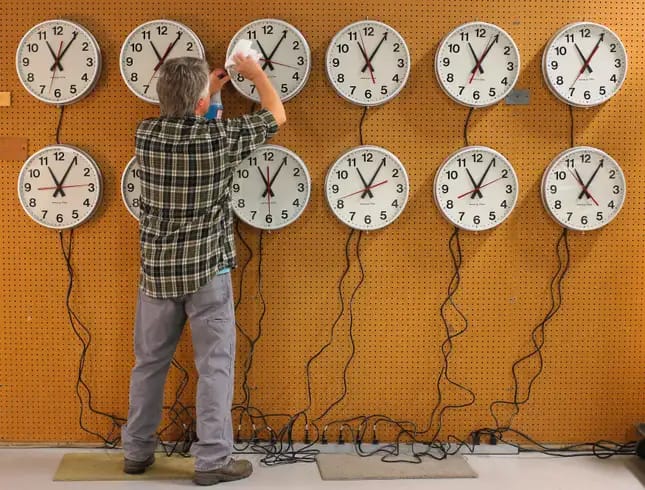As football fans notice subtle shifts in match times, they are drawn into the global phenomenon of Daylight Saving Time. The motivations behind its adoption create debates and ignite discussions among farmers, policymakers, and beyond, revealing surprising impacts on everything from sleep patterns to workplace safety.
By Mudabbir Ahmad Tak
It might not directly concern us, and many of us might not even have noticed it. But those of us who watch football matches from the European leagues, like English Premier League, La Liga, Bundesliga etc., might have noticed a change in the timings of the broadcast of these games. Are these matches being played at different times now? Those who have travelled to Europe or other Western countries might also have noticed a peculiar phenomenon related to time in these countries- twice a year, the times are changed throughout these countries!
It is called Daylight Saving Time, and it is also known as summer time. It involves uniformly advancing clocks throughout a country in order to extend daylight hours during seasonal changes which lead to the duration of days being changed. In the countries in the Northern Hemisphere, clocks are usually set ahead one hour in late March or in April and are set back one hour in late September or in October.
Daylight Saving Time thus involves setting clocks forward by one hour in either the late winter or spring, and to set clocks back by one hour in autumn to return to standard time. As a result, there is one 23-hour day in early spring and one 25-hour day in the middle of autumn. This allows people to make use of daylight for the maximum time and, in principle, is said to increase productivity. Thus, while we here might be watching the football games at a different time, the matches are being played at the same time in Europe!

History
Adopting a procedure to change times for maximum utilisation of daylight was first suggested by the American scientist and philosopher Benjamin Franklin in a letter in 1784. He wrote the letter to the editor of The Journal of Paris, suggesting that waking up earlier in the summer would economize on candle usage; and calculated considerable savings. In 1810, the Spanish National Assembly Cortes of Cádiz issued a regulation that moved certain meeting times forward by one hour from May 1 to September 30 in recognition of seasonal changes, but it did not change the clocks. It also acknowledged that private businesses were in the practice of changing their opening hours to suit daylight conditions, but they did so of their volition.
In 1895, New Zealand entomologist and astronomer George Hudson proposed the idea of changing clocks by two hours every spring to the Wellington Philosophical Society. Later, in 1907 an Englishman, William Willett, also suggested setting the clock ahead by 80 minutes in four moves of 20 minutes each during April and the reverse in September, corresponding to the lengthening and shortening of daytime during different seasons. Willett arrived upon this proposition after observing how many Londoners slept through a large part of a summer day. He was also an avid golfer who disliked cutting short his round at dusk. His solution was to advance the clock during the summer, and he published the proposal 2 years later. Liberal Party Member of Parliament Robert Pearce took up the proposal, introducing the first Daylight Saving Bill to the British House of Commons on 12 February 1908. A select committee was set up to examine the issue, but Pearce' s bill didn’t become law and several other bills failed in the following years. Willett lobbied for the proposal in the UK until his death in 1915.
In 1908, Port Arthur in Ontario, Canada started using Daylight Saving Time. Starting on April 30, 1916, the German Empire and Austria-Hungary each organized the first nationwide implementation in their jurisdictions. Later, the practice was adopted by most Western nations because of the exigencies brought about by the First World War. Several countries, including Australia, Great Britain, Germany, and the United States, adopted summer Daylight Saving Time during the war to conserve fuel. This was done by reducing the need for artificial light. During the Second World War, clocks were kept continuously advanced by an hour in some countries. These included the United States, which followed the practice from February 9, 1942, to September 30, 1945; and England, which used “double summer time” during part of the year, advancing clocks two hours from Standard Time during the summer and one hour during the winter months. This was again done to save fuel through utilizing natural light during the day.
In the modern times, Daylight Saving Time began to be adopted to increase work efficiency in offices and industries. Many countries have used Daylight Saving Time at various times, particularly since the 1970s energy crisis. Earlier, Daylight Saving Time used to begin on the last Sunday in April and end on the last Sunday in October in the United States. But in 2007, the start date was moved to the second Sunday in March and the end date to the first Sunday in November. In most of the countries of western Europe, Daylight Saving Time starts on the last Sunday in March and ends on the last Sunday in October.

Daylight Saving Time is generally not observed near the Equator, where sunrise and sunset times don’t vary enough, and therefore there is no need to change the clocks. Some countries observe it only in some regions: for example, parts of Australia observe it, while other parts don’t; conversely, it’s not observed at some places at high latitudes because there are wide variations in sunrise and sunset times and a 1-hour shift would relatively not make much difference at all. The practice is not observed in most Asian and African countries either.
Usage in modern world the modern industrialized societies usually follow a clock-based schedule for daily activities. This schedule does not change throughout the course of the year. The time of day that individuals begin and end work in a factory, for example, remains constant year-round. In contrast, an agrarian society' s daily routines for work and personal conduct are more likely governed by the length of daylight hours. Depending upon solar time, which changes seasonally because of the Earth' s axial tilt, a farmer may be able to work for 6 hours in his field during winter, and 10 hours during the summer season. North and south of the tropics, daylight lasts longer in summer and shorter in winter, with the effect becoming greater the farther one moves away from the equator.
In principle, after synchronously resetting all clocks in a region to one hour ahead of standard time in spring in anticipation of longer daylight hours, individuals following a clock-based schedule will be awakened an hour earlier in the solar day than they would have otherwise. They will begin and complete daily work routines an hour earlier: in most cases they will have an extra hour of daylight available to them after their workday activities. Proponents of Daylight Saving Time argue that it also decreases energy consumption by reducing the need for lighting and heating, but the actual effect on overall energy use is heavily disputed.
Detractors
However, the system also has its detractors. For example, in contrast to the widely held myth that Daylight Saving Time was first implemented for the benefit of farmers, it is the farmers throughout the Western world who have been one of the strongest lobbying groups against the practice. The factors that influence farming schedules, such as morning dew and dairy cattle readiness to be milked, are ultimately dictated by the sun, so the time change introduces unnecessary challenges.
Recent studies have also indicated towards other harmful effects of Daylight Saving Time. There have been concerns about the health effects of Daylight Saving Time (DST). The practice might be linked to a higher risk of cardiac issues, depression and other psychiatric problems because of disrupted sleep schedules. There are also economic effects associated with the practice.
A study published last year by researchers from several business schools found that investors and capital market participants are slower to respond to accounting reports in the week after we “spring forward” — which falls in the middle of earnings season. Another set of business school researchers found that on the Monday following DST, there is a rise in workplace injuries because of the adverse effects of the practice on sleep schedules. It has also been thought of as a cause of decrease in workplace concentration as the mind takes time to adjust to the clock. It has also been linked to increase in car accidents.
One might argue that Daylight Saving Time has both benefits and hazards. Make what you will of this practice, but Daylight Saving Time is without doubt one of the most bizarre practices followed in the Western world.

Leave a Reply